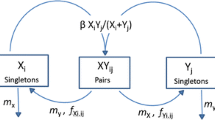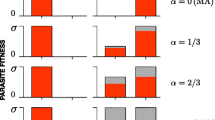Abstract
In geological history, rapid speciation, called adaptive radiation, has occurred repeatedly. The origins of such newly developing taxa often evolved from the symbiosis of different species. Mutualistic symbioses are generally considered to evolve from parasitic relationships. As well as the previous model of host population with discrete generations, a differential equation model of host population with overlapping generations shows that vertical transmission, defined as the direct transfer of infection from a parent host to its progeny, is an important factor which can stimulate reduction of parasite virulence. Evolution of the vertical transmission rate from both points of view, the parasite and the host, is analyzed. There is a critical level of the rate, below which an evolutionary conflict arises (the parasite would want an increase in the rate while the host would not), and above which both species would correspond to increase the rate. Therefore, once the parasite dominates the evolutionary race so as to overcome this critical level, one-way evolution begins toward a highly mutualistic relationship with a high vertical transmission rate, possibly creating a new organism through symbiosis with perfect vertical transmission. Changes in other parameters may decrease the critical level, initiating one-way evolution. However, changes in traits, probably developed through a long interrelationship in parasitism, do not necessarily induce the evolution of mutualism. Establishment of the ability to make use of metabolic and digestive wastes from the partner certainly facilitates the evolution of mutualism, while improvements in reproductive efficiency of parasites and reduction of negative effects from exploitation in hosts on the contrary disturb mutualism.
Similar content being viewed by others
References
Bremermann, H. J. and J. Pickering (1983) A game-theoretic model of parasitic virulence.Journal of Theoretical Biology 100: 411–426.
Breznak, J. A. (1975) Symbiotic relationships between termites and their intestinal microbiota.Symposia of the Society for Experimental Biology 29: 559–580.
Buchner, P. (1965)Endosymbiosis of animals with plant microorganisms. Wiley Interscience, New York.
Ewald, P. W. (1987) Transmission modes and evolution of the parasite-mutualism continuum.Annals of the New York Academy of Sciences 503 (Endocytobiology III): 295–305.
Ewald, P. W. (1994)Evolution of infectious disease. Oxford University Press, Oxford.
Fenner, F. (1965) Myxoma virus andOryctolagus cuniculus. pp. 485–501.In H. G. Baker and A. L. Stebbins (eds.)The genetics of colonizing species. Academic Press, New York.
Fleming, J. G. W. and M. D. Summers (1991) Polydnavirus DNA is integrated in the DNA of its parasitoid wasp host.Proceedings of National Academy of Sciences of the USA 88: 9770–9774.
Ishikawa, H. (1988)Symbiosis and evolution. Baihukan, Tokyo. (in Japanese)
Jeon, K. W. (1972) Development of cellular dependence in infective organisms: microsurgical studies in amoebas.Science 176: 1122–1123.
Klein, R. W., D. Kovac, A. Schellerich and U. Maschwitz (1992) Mealybug-carrying by swarming queens of a southeast Asian bamboo-inhabiting ant.Naturwissenschaften 79: 422–423.
Margulis, L. (1993)Symbiosis in cell evolution. 2nd ed. Freeman, New York.
May, R. and R. Anderson (1983) Epidemiology and genetics in the coevolution of parasites and hosts.Proceeding of Royal Society, London, Series B 219: 281–313.
May, R. and M. Nowak (1995) Coinfection and the evolution of parasite virulence.Proceeding of Royal Society, London, Series B 261: 209–215.
Maynard-Smith, J. (1974) The theory of games and the evolution of animal conflicts,Journal of Theoretical Biology 47: 209–221.
Maynard-Smith, J. (1982)Evolution and the theory of games. Cambridge University Press, Cambridge.
Maynard Smith, J. (1989) Generating novelty by symbiosis.Nature 341: 284–285.
McFadden, G. and P. Gilson (1995) Something borrowed, something green: lateral transfer of chloroplasts by secondary endosymbiosis.Trends in Ecology and Evolution 10: 12–17.
Nowak, M. (1991) The evolution of viruses. Competition between horizontal and vertical transmission of mobile genes.Journal of Theoretical Biology 150: 339–347.
Price, P. W. (1991) The web of life: Development over 3.8 billion years of trophic relationships. pp. 262–272.In L. Margulis and R. Fester (eds.)Symbiosis as a source of evolutionary innovation. The MIT press, Cambridge.
Roughgarden, J. (1975) Evolution of marine symbiosis—A simple cost-benefit model.Ecology 56: 1201–1208.
Sasaki, A. and Y. Iwasa (1991) Optimal growth schedule of pathogens within a host: switching between lytic and latent cycles.Theoretical Population Biology 39: 201–239.
Stolts, D. B. and S. B. Vinson (1979) Viruses and parasitism in insects.Advances in Virus Research 24: 125–171.
Yamamura, N. (1987) Evolutionary stable strategy (ESS) models of copulation and mate guarding. pp. 197–211.In Y. Ito, J. L. Brown and J. Kikkawa (eds.)Animal societies, theories and facts. Japan Scientific Societies Press, Tokyo.
Yamamura, N. (1993) Vertical transmission and evolution of mutualism from parasitism.Theoretical Population Biology 44: 95–109.
Yamamura, N. (1996) Diversity and evolution of symbiotic interaction.In T. Abe, S. A. Levin and M. Higashi (eds.)Biodiversity: an ecological perspective. Springer, New York. (in press)
Yamamura, N. and M. Higashi (1992) An evolutionary theory of conflict resolution between relatives: altruism, manipulation, compromise.Evolution 46: 1236–1239.
Author information
Authors and Affiliations
Rights and permissions
About this article
Cite this article
Yamamura, N. Evolution of mutualistic symbiosis: A differential equation model. Res Popul Ecol 38, 211–218 (1996). https://doi.org/10.1007/BF02515729
Received:
Accepted:
Issue Date:
DOI: https://doi.org/10.1007/BF02515729




